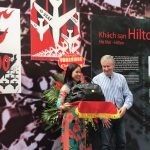The exhibition’s topic is divided into 4 categories: Confronting B52, Hilton Hanoi Hotel, Day of Return, and Building Future. The images, materials, and items at the exhibition represent part of the struggle and victory of the troops and people of Hanoi and Hai Phong in the “Dien Bien Phu in the air” campaign of December 1972. They tell wartime stories filled with surprises and rich humanities, especially stories of American pilots once detained at “Hilton Hanoi Hotel” on their returns to Vietnam to find memories of the places where their aircrafts were shot down and where they were detained, also on their meetings with those who shot down the aircrafts or cared for and protected them in the past.
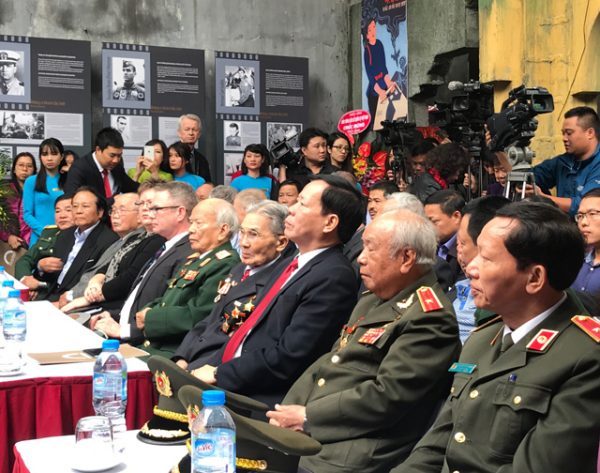
Delegates at the opening ceremony of the “Finding Memories” exhibition
“Confronting B52” is the first category of the exhibition. It contains images of Ha Noi and Hai Phong taken in the 12 days and nights of December 1972 when the two cities and several others were attacked by war bombs that caused vast destruction. With an unshakable faith in victory, the troops and people of Hanoi and Hai Phong did not give in and tirelessly fought in each traffic trench in the spirit of “Turning each village into a fortress, turning each citizen into a soldier”. Looking back at the moments of Hanoi and Hai Phong in those days, apart from sadness and grief, visitors would still see in the photos a shining faith in victory. It was the love and dedication that created the epic that revived life under bombing attacks as addressed by President Ho Chi Minh: “Hanoi, Haiphong, and other cities and enterprises may be destroyed, but the Vietnamese people will not be intimidated! Nothing is more precious than independence and freedom. When victory day comes, our people will rebuild our country and endow it with bigger and more beautiful construction.”
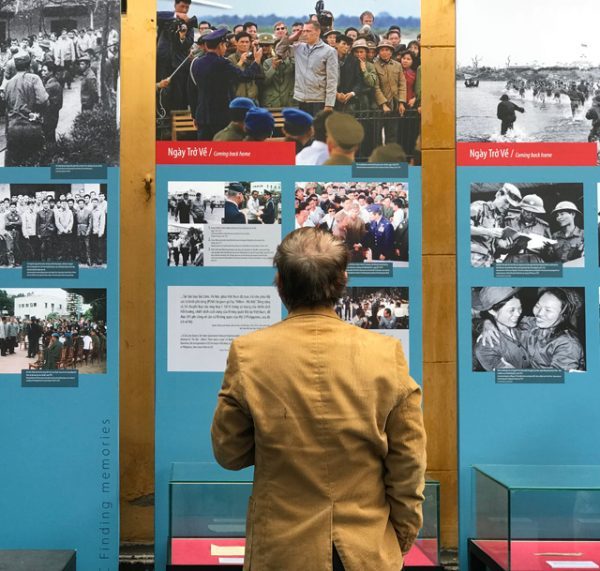
The “Hilton Hanoi Hotel” category of the exhibition will bring to those who have not experienced the war more wartime stories, especially the stories of those who managed and protected US pilots in Hoa Lo Prison interwoven with the stories of some US pilots arrested and detained there, such as Navy Lieutenant Everett Alvarez Jr., the first pilot with aircraft shot down in North Vietnam and the one that had the longest detention time at “Hilton Hanoi Hotel”, or Navy Lieutenant Colonel Walter Eugene Wilber, Corporal Robert P. Chenoweth, Marine Corps Lieutenant Colonel Marshal Edison W. Miller, the ones who are properly aware of the war they were in, or Navy Captain John Sidney McCain, Air Force Captain Douglas (Pete) Peterson, the ones who have carried out many activities to heal the post-war Vietnam-US relation.
January 27, 1973 marked the signing of the Paris Peace Accords, or the Agreement on Ending the War and Restoring Peace in Vietnam. The governments of Vietnam and the United States proceeded to hand over those detained by both parties. Their own faces filled with emotions and tears of happiness when embraced in the arms of relatives have become memories engraved in the minds of those who returned after the war. Hidden in each photo and item of the “Day of Return” category of the exhibition are touching stories about warm love of couples and maternity love that enveloped the Vietnamese political prisoners who were finally handed over by the US in Nhan Bien by Thach Han River, Quang Tri Province after many years of imprisonment, as well as the stories of the American pilots who were handed over at Gia Lam Airport, Hanoi.
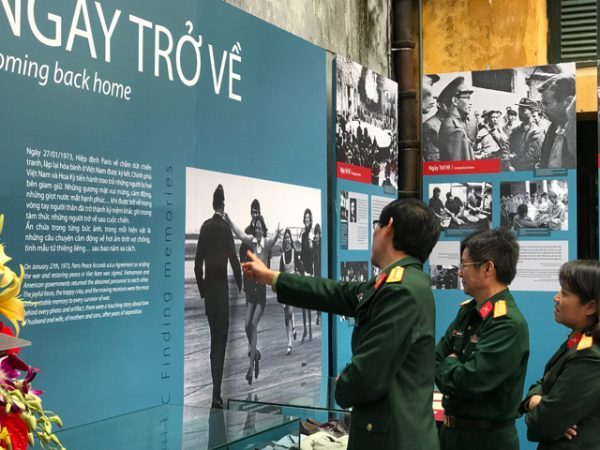
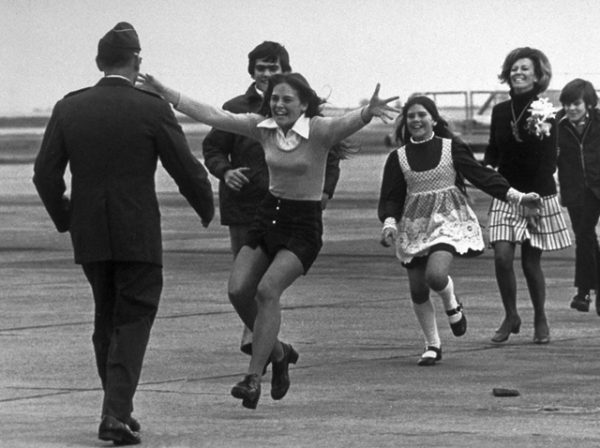
The happiness of family members of Lt. Col. Robert L. Stirm upon welcoming him home at the Travis Air Force Base, California on March 17, 1973 (Photo by Sal Velder)
“Building Future” is the last category of the exhibition, expressing the love for peace of the Vietnamese people who understand deeply the value of peace more than anyone else. Since 1973, the Government of Vietnam has actively searched for and returned the remains of American soldiers missing in the war. In 1989, the United States Government also cooperated with Vietnam in search operations. These “returns”, although not complete, somewhat helped heal and sooth the wartime grief. Nowadays, American veterans return to Vietnam to find indelible memories of their military career and Hoa Lo Prison is part of those. All these activities are aimed at building good relations between Vietnam and the United States.
Mrs. Nguyen Thi Bich Thuy, Head of Management Board of Hoa Lo Prison Relic Site, affirmed in her speech at the opening ceremony: ““Finding Memories” is an occasion for Vietnamese people to be proud of the miracle that they created in the twentieth century, a place for the American pilots to remember a particular period in their lives, and an opportunity for those who have not experienced war to read and hear more about wartime stories, especially those of American pilots at “Hilton Hanoi Hotel”. Today, the wounds of war have partially been healed and the sadness has easied. Many American veterans have returned to Vietnam to find back the unforgettable memories of their military career. Veteran Robert P. Chenoweth is one of those.”
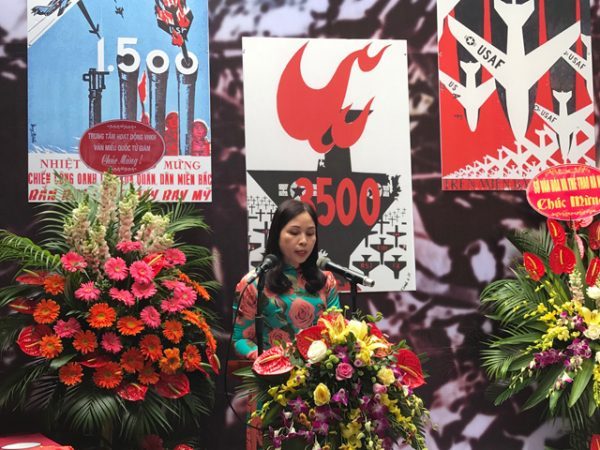
Mrs. Nguyen Thi Bich Thuy, Head of Management Board of Hoa Lo Prison Relic Site
At the opening ceremony of the “Finding Memories” exhibition, delegates and visitors met witnesses who experienced those fierce days and nights in 1972 as well as two special guests from the United States, Corporal Robert P. Chenoweth, who had spent time at the “Hilton Hanoi Hotel”, and Thomas Eugene Wilber, the son of Navy Lieutenant Colonel Walter Eugene Wilber (a prisoner of Hoa Lo Prison).
In his return to the “Hilton Hanoi Hotel” this time, Mr. Robert P. Chenoweth (nicknamed Bob) brought along 20 mementoes he took with him when he returned to the US nearly 45 years ago. Those mementoes, called his “flesh and blood”, have now been handed over to the officers of a museum in a country halfway around the world from his own. His reason for handing over the mementoes to the management board of Hoa Lo Prison Relic Site was for them to be introduced to the public at the “Finding Memories” exhibition and many other exhibitions in the future with a hope that these objects would continue to promote their own values.
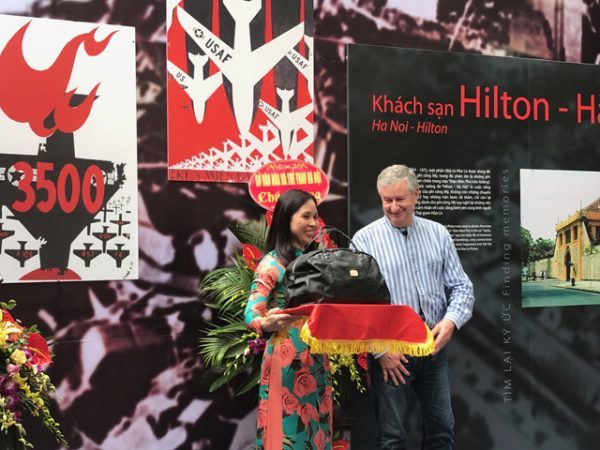
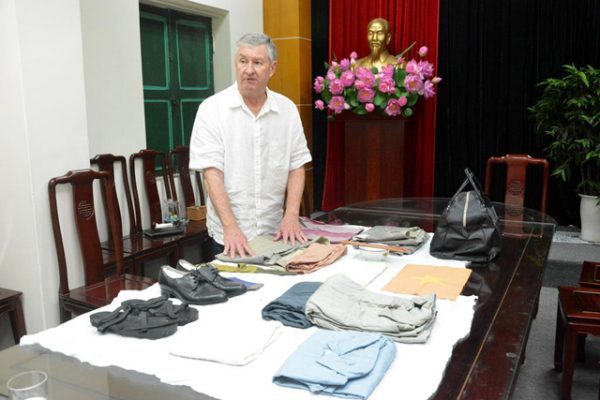
Robert P. Chenoweth by the mementoes he brought from the United States to donate to the management board of Hoa Lo Prison Relic Site
These items were military supplies Bob had been given for use during his detention in North Vietnam, including long pants, shorts, face towels, rubber slippers, bowls, and chopsticks, especially a pair of red chopsticks that, according to Bob, was used for holiday and New Year meals only. They were also military uniforms that Bob and his fellow men were equipped with and used when returned home in March 1973, including: a set of long shirt and pair of trousers, a shirt, a hand bag, and so on.
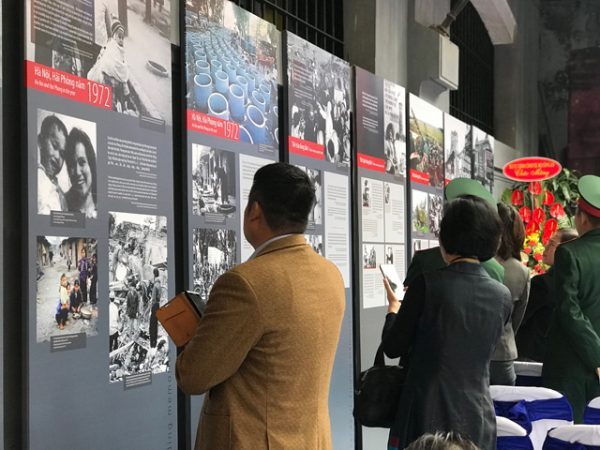

“Finding Memories” has attracted the attention of not only the citizens of the capital city but also foreign visitors
Forty-five years have passed. The Vietnamese people of today still appreciate American peace lovers. The “Finding Memories” exhibition is an occasion for Vietnamese people to be proud of the miracle that they created in the twentieth century, a place for the American pilots to remember a particular period in their lives, and a destination for visitors to understand more about the severity of war in order to contribute to building a peaceful world.
TN

